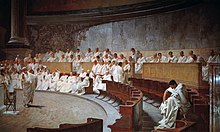Palazzo Madama (Rome)
The Palazzo Madama in Rome is the seat of the Italian Senate . The palace is located in the square of the same name on Corso Rinascimento . The palace owes its name to Madama Margaret of Austria , daughter of Charles V , who was first married to Alessandro de 'Medici and lived in this palace.
Metonymically , Palazzo Madama is often used in the Italian press when referring to the Senate (as an organ). The President of the Senate does not have his residence in Palazzo Madama, but in the neighboring Palazzo Giustiniani .
history

Towards the end of the 15th century, the Bishop of Chiusi and treasurer of Pope Sixtus IV had a palace built on the property, which was acquired after his death by Giovanni de 'Medici, who later became Pope Leo X , and who built him on the basis from plans Giuliano da Sangallos wanted to rebuild, a project that was not carried out. The widow of Alessandro de 'Medici, married to Ottavio Farnese for the second time , chose the palace as her residence. After that, the Italian Cardinal Francesco Maria Bourbon Del Monte lived in the palace and died in the palace in 1627. During this time the artist Caravaggio also lived temporarily in the palace. Again in the possession of the Medici, it was rebuilt between 1642 and 1649 by the architect Paolo Marucelli and given its current baroque facade.
The palace then fell to the Lorenese family by inheritance, was acquired by Pope Benedict XIV in 1750 and served as the papal court of justice and under Pius IX. as the seat of various papal authorities.
In February 1871 the palace became the seat of the Senate after Rome was declared the capital of the Kingdom of Italy in the course of the Risorgimento . The new use required extensive renovations. Among other things, a large auditorium was built as a meeting room in which the Senate met for its first session in November 1871.
Architecture and interior design
The facade designed by Marucelli is nine-axis, has three floors and a mezzanine floor . It is smoothly plastered and is structured by friezes made of light limestone and emphasized at the corners by rustic pilasters . The mezzanine windows are integrated into a richly decorated frieze . The windows are crowned with splendid segment gables and triangular gables. Two columns flank the portal and support a balcony.
The domed auditorium was built on the space of a former courtyard by the architect Luigi Gabet.
Various halls of the Senate are decorated with large historicist murals about the Roman Senate . One of the frescoes shows Cicero's accusation against Catiline by Cesare Maccari from 1888.
Coordinates: 41 ° 53 ′ 56.9 " N , 12 ° 28 ′ 27.8" E
literature
- Vittorio del Gaizo: Il Palazzo Madama sede del senato . Edizioni d'Italia, Roma, 1969. ISBN 3-8290-2258-1 .
Web links
See also
- Palazzo Montecitorio , seat of the Chamber of Deputies
Individual evidence
- ^ Eugenio Lo Sardo, Archivio di Stati: Caravaggio a Roma, una vita dal vero , p. 37, De Luca Editori d'Arte, Rome 2011. ISBN 978-88-6557-009-8

